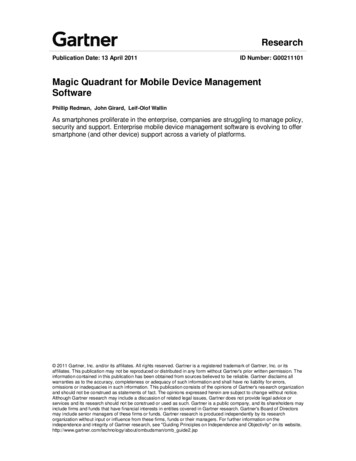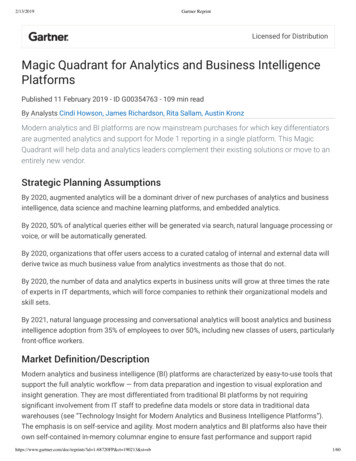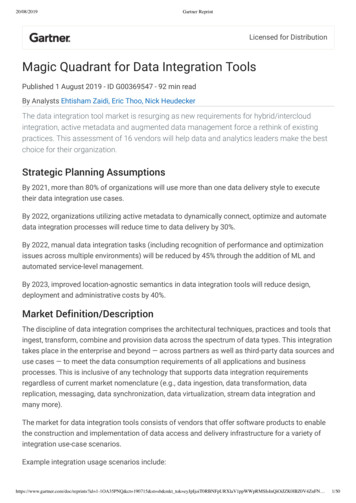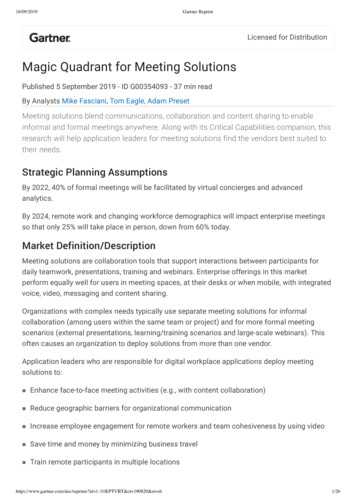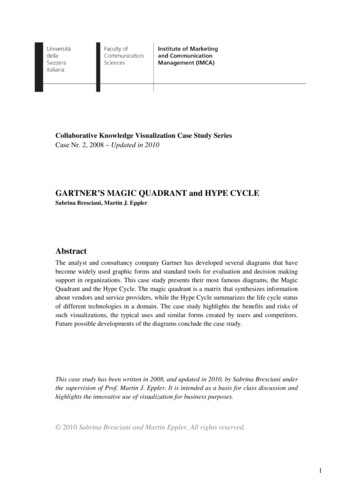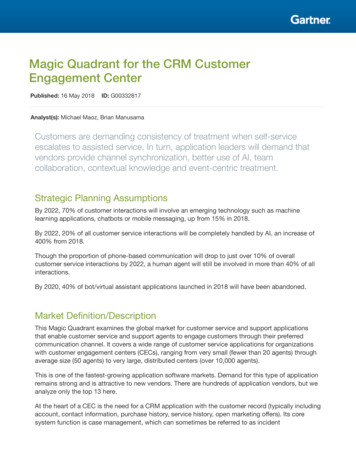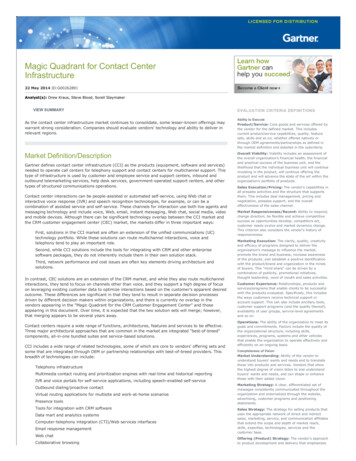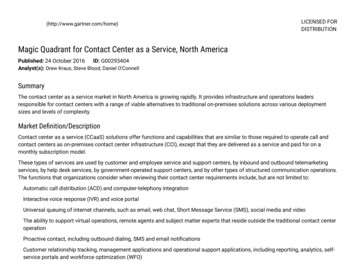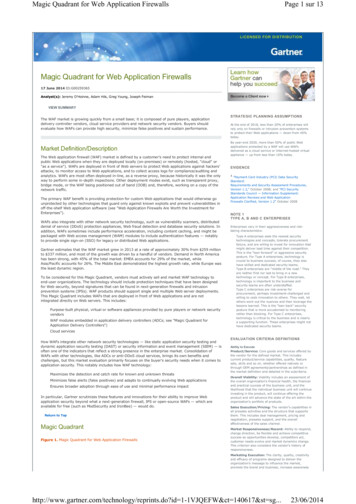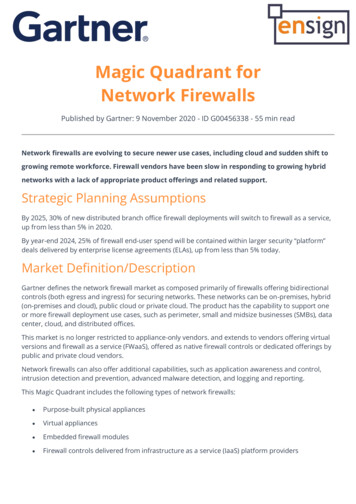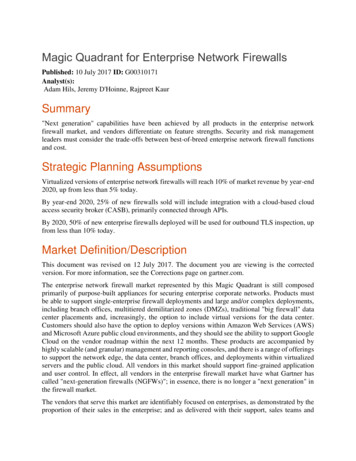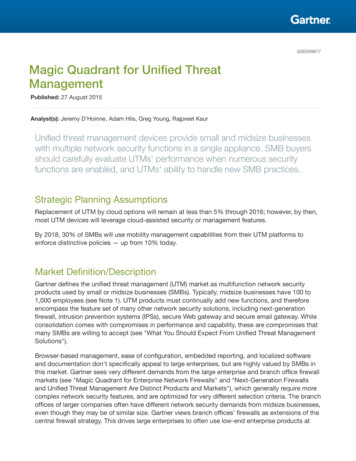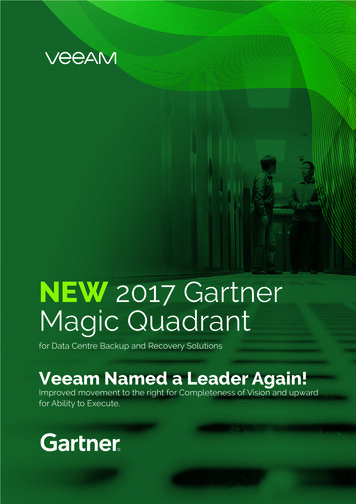
Transcription
NEW 2017 GartnerMagic Quadrantfor Data Centre Backup and Recovery SolutionsVeeam Named a Leader Again!Improved movement to the right for Completeness of Vision and upwardfor Ability to Execute.1
Contents2Summary03Marketing Definition/Description04Magic Quadrant05Vendor Strengths andCautions06Inclusion and ExclusionCriteria13Evaluation Criteria14Quadrant Descriptions17Context19Market Overview20Evidence21Evaluation CriteriaDefinitions22
By2021, 50% of organizations willaugment or replace their current backupapplication with another solution, compared towhat they deployed at the beginning of 2017.By2022, 20% of storage systems will beself-protecting, obviating the need for backupapplications, up from less than 5% today.SummaryBy2020, 30% of large enterprises willleverage snapshots and backup for more thanjust operational recovery (e.g., disaster recovery,Enterprise backup is amongtest/development, DevOps, etc.), up from lessthe most critical tasks forthan 15% at the beginning of 2017.infrastructure and operations2020, 30% of organizations willprofessionals. Gartner providesByanalysis and evaluation ofhave replaced traditional backup applicationsthe leading data centerwith storage- or HCIS-native functions for thebackup solution vendors thatmajority backup workloads, up from 15% today.offer a range of traditionalto innovative availabilitycapabilities.By2020, the number of enterprises usingthe cloud as a backup target will double, upfrom 10% at the beginning of 2017.By2021, over 50% of organizations willsupplant backup with archiving for long-termdata retention, up from 30% in 2017.By2019, despite increasing effectivenessof countermeasures, successful ransomwareattacks will double in frequency year over year,up from 2 to 3 million in 2016.3
Market Definition/DescriptionGartner defines data center backup andrecovery solutions as those solutionsfocused on providing backup capabilitiesfor the upper-end midmarket and largeenterprise environments. Gartnerdefines the upper-end midmarketas being 500 to 999 employees, andthe large enterprise as being 1,000employees or more. Protected datacomprises data center workloads, suchas file share, file system, operatingsystem, hypervisor, database, email,content management, CRM, ERP andcollaboration application data. Today,these workloads are largely on-premises;however, protecting SaaS applications(such as Salesforce and Microsoft Office365 [O365]) and infrastructure as aservice (IaaS) are becoming increasinglyimportant, as are other, newer “bornin the public, private or hybrid cloud”applications.These backup and recovery solutions provide writingdata to tape, conventional random access media(such as a hard disk or solid-state drives) or devicesthat emulate the previous backup targets (such asvirtual tape library [VTL]). Data services, such as datareduction (compression, deduplication or singleinstancing), array and/or server-based snapshot,heterogeneous replication (from/to dissimilardevices), and near-continuous data protection (nearCDP) can also be offered. Exploiting convergeddata management (also referred to as “copy datamanagement”) has become important; here, backupdata is leveraged for additional use cases, suchas analytics, disaster recovery, test/dev, reportingand so on (see “Predicts 2017: Business ContinuityManagement and IT Service Continuity Management”). In particular, the concept of performing a live4mount of the backup data, prior to actually restoringit — making it usable nearly instantly, then usingtools, such as VMware’s Storage vMotion, to move thedata from the backup store to primary storage — hasbecome table stakes in the market.Additionally, integration and exploitation of the cloud,particularly the public cloud, or on-premises objectstorage as a backup target or to a colocation facilityare becoming more important for backup workloads,despite modest deployment to date.As the backup and recovery market has hundredsof vendors, this report narrows the focus down tothose that have a very strong presence worldwidein the upper-end midmarket and large enterpriseenvironments. Solutions that are predominantly soldas a service (backup as a service [BaaS]) do not meetthe market definition for inclusion. Software for ahomogeneous environment, such as native tools fromMicrosoft or VMware, primarily for their own platforms,are also excluded, as many midsize and large customersprefer a more heterogeneous, scalable backup productfor their environments.Provider solutions that primarily address backup andrecovery of remote office, small enterprise, individualsystem and/or an endpoint device data are outsideof the scope of this data-center-oriented focus. Someproviders may, however, also address these workloads,as well as the larger data center workloads describedabove. However, those are not the primary use casesfor deploying these data center solutions.This 2017 “Magic Quadrant for Data Center Backupand Recovery Solutions” is an update to the “MagicQuadrant for Data Center Backup and RecoverySoftware” that was last published in June 2016. Theslightly renamed Magic Quadrant (change of wordingfrom “Software” to “Solutions”) and updated marketcriteria are driven by expanding packaging options (forexample, physical and virtual appliances).Note that Gartner analysts may need to update themarket definition as they progress through the researchprocess. You will be explicitly notified of the change(s),should they need to happen.
Magic QuadrantFigure 1. Magic Quadrant for Data Center Backup and Recovery SolutionsCHALLENGERSLEADERSDELL EMCCOMMVAULTIBMVERITAS Y TO EXECUTERUBRIKNICHE PLAYERSCOMPLETENESS OF VISION5VISIONARIESAs of July 2017
Vendor Strengths and CautionsActifioCautionsActifio first came to market as a data virtualizationappliance with its pioneering copy data managementcapability. The concept of copy data collapsed thenumber of secondary copies of data (archive, backup,disaster recovery, test/dev and so on) by keeping asingle golden image of the data. Today, the solutioncan still be deployed as an appliance, but also assoftware-only or as a virtual appliance, and oftenin the cloud. Actifio protects a range of workloads,but excels at large-scale virtual environment andlarge applications, especially Oracle instances.Actifio is praised for its ease of management via anintuitive administrative console and SLA-driven policymanagement that facilitates end-to-end applicationprotection. In 1Q17, Actifio expanded on its copy datamessage, and now positions itself as an enterprisedata-as-a-service (EDaaS) solution that provides dataavailability and archive capabilities, as well as hybridcloud mobility and faster application development(DevOps). In late 2017, Actifio will add a catalog forfaster search of virtual machine data. Pricing is viaa simplified front-end capacity-based model. Oncedeployed, Actifio receives positive feedback for theability to easily protect large environments. Some customers have stated that initialdeployments can require extra care and effort inorder to properly configure the solution. Actifio is mostly deployed in North America andspecific countries in Europe, but has been gainingtraction in more of Europe and especially inJapan. Actifio is most often deployed in largerenterprises with large amounts of data, andis only recently beginning to examine smallerenterprise routes to market with its streamlinedActifio One product.Strengths6 Actifio successfully pioneered copy datamanagement and delivers a single platform thatintegrates backup, disaster recovery and longterm data retention, but that can be used forbroader data management, such as applicationdevelopment and facilitating multidirectionalhybrid cloud deployments. Actifio offers scalable, writeable instantrecovery for applications, files and virtualmachines (VMs), including physical, as well asvirtual, workloads. Customer and references praise Actifio’s ease ofuse and customer support.ArcserveArcserve offers two different backup products: ArcserveUnified Data Protection (UDP), which is available assoftware-only and as an integrated solution via theArcserve UDP Appliance, and the legacy ArcserveBackup offering. The majority of the company’s effortsare focused on the UDP solution, with capabilitiesfrom Arcserve Backup embedded in to UDP via acommon console and a single installer. This researchprimarily focuses on UDP. Now independent fromCA Technologies for three years, Arcserve as a standalone company has been investing in researchand development, marketing and sales expansion.These efforts have made Arcserve one of the fewbackup vendors in the industry that is experiencingmarket share growth. In 2Q17, Arcserve acquiredtwo companies: Zetta for cloud backup and disasterrecovery, and FastArchiver for email archiving. Zetta willextend Arcserve’s backup-to-the-cloud, remote locationand failover-to-the-cloud capabilities. Arcserve protectsvirtual and physical environments, offering robust cloudintegration, virtual standby and recovery assurancecapabilities. Arcserve offers a broad range of packagingand pricing options. Arcserve is focused on the mediumto large midsize enterprise and the decentralized largeenterprise, typically with 250 to 2,500 employees.
Vendor Strengths and CautionsStrengths Arcserve UDP offers comprehensive backup,continuous data protection, high availability anddisaster recovery for physical, virtual and cloudenvironments. References rate UDP high on ease ofdeployment. Arcserve offers a variety of packaging,deployment and pricing options, allowingcustomers to choose just the function that theyneed at a favorable price.CautionsStrengths Commvault has comprehensive and leadingpublic cloud support as well as protection of O365and Salesforce. IntelliSnap features the industry’s broadestsupport for integrating with and exploitingstorage hardware platform snapshots, directlysupporting over two dozen of the top-sellingstorage arrays.Customers and references report a very highlikelihood to repurchase the solution. Gartner end-user inquiry and reference checksgive low marks to Arcserve’s technical support. Arcserve is typically not deployed in large datacenters where Oracle RAC is often required. While well-deployed in Japan and parts ofEurope, North American deployments continueto lag.Cautions CommvaultCommvault has the most expansive list of supportedpublic cloud providers, hypervisors, big data supportand database protection, providing technologicalliberty for future procurement decisions in otherareas of the data center and beyond. Commvaultis primarily offered as a software-only solution, buthas an appliance as an option. Aside from protectingmore exotic and newer technologies, coverage fortraditional physical and on-premises applications isend-to-end and complete. Building on its early lead,Commvault is adding orchestration to its machineconversion capabilities to enable migration of wholeapplications to the cloud. Commvault is primarilylicensed by capacity for physical servers, by socket orVM bundles for hypervisors, and by VM bundles forportability from virtual environments to the cloud.7Despite the 2016 pricing revision and popularsolution set bundles, Commvault has not beenable to completely get rid of its now-undeservedreputation as an expensive vendor. Customer supportand satisfaction feedback remain very favorable.While Commvault does have a unified interface, it iscomplex in a commensurate measure to its capability.Commvault has introduced administrator-personaoriented, simplified UIs to improve ease of use. Implementing Commvault is relatively complex,and often requires professional services. Administrators report that the product has aninitial steep learning curve, which makes traininga prerequisite. Field sales will generally lead with VM bundles,which may not be the most cost-effectivelicensing model for very dense VM-per-socketenvironments, where socket-based licensingwould be less expensive.
Vendor Strengths and CautionsDell EMCDell EMC offers data center backup software inmultiple editions of Data Protection Suite (DP Suite).The suites are sales bundles of relevant backupproducts, including Avamar and/or NetWorker asthe key backup engines, augmented with alternativebackup methods and additional capabilities throughother components such as DD Boost for EnterpriseApplications, ProtectPoint, CloudBoost, Searchand Data Protection Advisor (DPA). (Note that theData Domain appliances are not evaluated in thisresearch.) The newly launched all-in-one IntegratedData Protection Appliance (IDPA) combines DataDomain with Avamar and DD Boost for EnterpriseApplications. Dell EMC now supports emerging bigdata workloads such as Hadoop and MongoDB. DPSuite has significantly improved support of publiccloud storage for both long-term retention and costeffective disaster recovery of backup data, as well asprotecting cloud-native data. Avamar is well-knownfor its storage and WAN efficiency and strong filebackup, while NetWorker has stronger support forheterogeneous environments with different physicalservers and database applications. Key roadmap itemsbefore year-end 2017 include a centralized dashboardfor all DP Suite components and a backup-as-a-servicesolution to manage Amazon cloud-native backups.However, heavy dependence on Data Domain andmanagement complexity with multiple managementconsoles remain top customer concerns.Strengths8 Dell EMC offers aggressive discounts and oftenhigh attach rates of its backup solution to itsprimary storage sales. The Integrated Data Protection Appliances arepartially addressing the long-existing complexityof managing various components of DP Suiteplus Data Domain. Dell EMC is one of the few vendors offering theuse of low-cost cloud object storage for backupbased DR without persistent usage of cloudcompute.Cautions Dell EMC’s data protection portfolio often resultsin lock-in into the Data Domain and other DellEMC hardware platforms due to high attach ratesto EMC hardware. With the centralized DP Suite dashboard still inthe works, DP Suite management and supportcontinue to be fragmented and complex. Some large database backup solutions suchas ProtectPoint and DD Boost for EnterpriseApplications may require evaluation by databaseadministrators and application owners.HPEHewlett Packard Enterprise (HPE) Data Protectoris a software-only traditional data center backupproduct, typically deployed in conjunction with tape ordeduplication backup target appliances such as HPEStoreOnce and Dell EMC Data Domain. Data Protectoris a single, scalable solution supporting a range of hostenvironments, with some gaps, and offering nativeintegration with many enterprise core applications,especially SAP. HPE announced in the fall of 2016the pending spinoff/merge of its software assets,including Data Protector, to Micro Focus, which willbe completed in the fall of 2017. In the last year, HPEcompleted a much-overdue Data Protector graphicaluser interface (GUI) overhaul, improved back-endproduct communication, and added backup analyticsenhancements to the Backup Navigator product forproblem remediation and service-level assurance.Roadmap items focus on enhancements including selfservice restore and the integration of VM Explorer intothe core product, along with further improvements toBackup Navigator. HPE offers Data Protector as part ofthe Adaptive Backup and Recovery (ABR) Suite, licensedby suite level, or as a stand-alone product licensed byfeature or capacity. Data Protector is rated lower thanother vendors in this research for the lack of innovationand execution compared to major competitors.
Vendor Strengths and CautionsStrengths HPE Data Protector has good, heterogeneousOS, database and file system support. Backup Navigator and Storage Optimizerprovide analytics and visibility to the backupand storage environment. HPE is a good value from a cost perspectiveif the use case is traditional on-premisesenterprise backup requirements.in a larger, vertically aligned direct sales groupwith a greater focus on new-customer acquisitionand customer retention. In late 2017, SpectrumProtect’s Operations Center will add a new securitydashboard and add broader historical reporting fortrend analysis. Spectrum Protect is a component ofIBM’s software-defined storage (SDS) strategy, withIBM offering a Spectrum Storage Suite that allowsfor deployment of any of IBM’s SDS products undera single license. While the Operations Center wasreleased four years ago and has been continuallyenhanced, Spectrum Protect’s ease of use andadministrative console receive very mixed feedback.CautionsStrengths 9The upcoming Micro Focus spin-merge mayfurther weaken Data Protector’s (and thus theABR Suite’s) strategic cross-divisional focus andrelationship with HPE Storage, which now alsoresells Veeam. HPE does not offer socket or VM bundle-basedpricing, and references cite dissatisfaction withpackaging and pricing. Support for Microsoft Hyper-V requires agentsin the guest virtual machines. A single instance of Spectrum Protect can protecta very scalable 4PB to 5PB of data. Spectrum Protect’s new cloud acceleratorcapability boosts performance up to manyTB/hour in a single Spectrum Protect serverinstance when writing to cloud storage, enablingcustomers to leverage the cloud for largeenvironments. Customer support is rated highly by references.IBMCautionsIBM’s Spectrum Protect is offered as software fromIBM, or as an appliance from third-party partners,and can be deployed to protect small to extremelylarge enterprises. Spectrum Protect supportsphysical and virtual environments, as well as abroad mix of applications, operating systems andbackup target devices. Of note, DB2 and Domino,AIX, iSeries and zLinux, and robust physical tapesupport and media-tracking capability stand out.IBM remains unique with its highly scalable twotier architecture, along with its incremental-forevermethodology, which results in potentially lower totalcost of ownership due to reduced infrastructurerequirements. In early 2017, IBM united its salesforce into one holistic storage seller, resulting Gartner end-user inquiry and customerreferences give Spectrum Protect the lowestmarks for ease of management of all of theproducts in this Magic Quadrant, even thoughIBM states that it has invested in improving theuser experience in several areas in recent years. Perceptions of being high-priced remain, mainlydue to processor value unit (PVU) pricing that washistorically predominant in North America andthat it is often used in the rest of world, despitecapacity-based alternatives. Spectrum Protect’s deduplication is not globalacross all Spectrum Protect server instances;rather, it is constrained to a single storage pool.
Vendor Strengths and CautionsRubrikRubrik offers an integrated backup appliancewith a scale-out architecture that offers globaldeduplication and ease of expansion. Despite beinga new entrant to the market, Rubrik has generatedheightened market awareness and rapid adoptionby upper midsize to large enterprises, augmentingor completely replacing mainstream data centerbackup solutions. By using modern backup andrecovery techniques and a distributed metadataand task scheduler, Rubrik’s backup appliancesremove dependency on external databases andstorage controllers to manage backup and storage,drastically simplifying the backup software andhardware infrastructure. Its software instance canrun in remote offices or in Amazon Web Services(AWS) and Microsoft Azure to back up cloud-nativedata, or serve as a replication target. Rubrik alsosimplified its pricing practices by offering two mainoptions: all-in-one appliance licensing (with separatesupport) or subscription-based licensing (includingsupport) for its software instances. However, Rubrikis quite limited with its support matrix today, andcan back up VMware virtual machines, Windows andLinux physical serve
This 2017 “Magic Quadrant for Data Center Backup and Recovery Solutions” is an update to the “Magic Quadrant for Data Center Backup and Recovery Software” that was last published in June 2016. The slightly renamed Magic Quadrant (change of wording from “Software” to “Solutions”) and updated market
